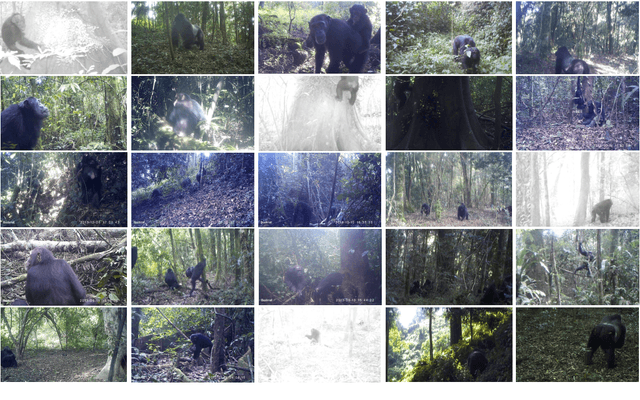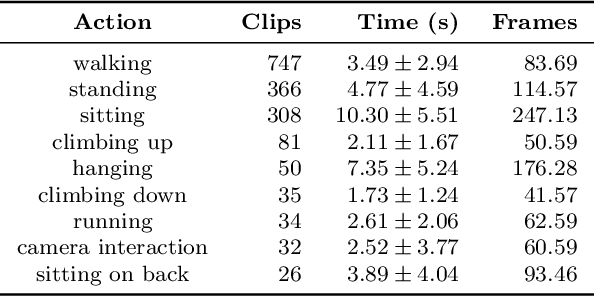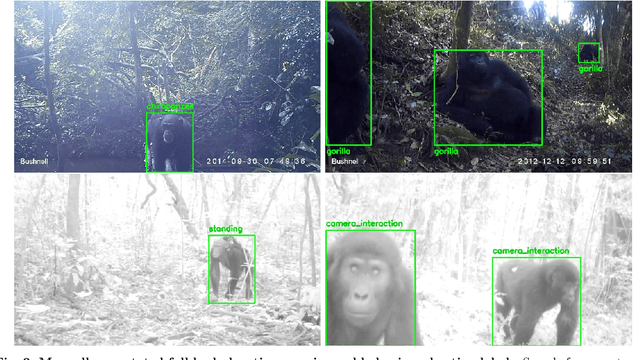Maureen S. McCarthy
The PanAf-FGBG Dataset: Understanding the Impact of Backgrounds in Wildlife Behaviour Recognition
Feb 28, 2025Abstract:Computer vision analysis of camera trap video footage is essential for wildlife conservation, as captured behaviours offer some of the earliest indicators of changes in population health. Recently, several high-impact animal behaviour datasets and methods have been introduced to encourage their use; however, the role of behaviour-correlated background information and its significant effect on out-of-distribution generalisation remain unexplored. In response, we present the PanAf-FGBG dataset, featuring 20 hours of wild chimpanzee behaviours, recorded at over 350 individual camera locations. Uniquely, it pairs every video with a chimpanzee (referred to as a foreground video) with a corresponding background video (with no chimpanzee) from the same camera location. We present two views of the dataset: one with overlapping camera locations and one with disjoint locations. This setup enables, for the first time, direct evaluation of in-distribution and out-of-distribution conditions, and for the impact of backgrounds on behaviour recognition models to be quantified. All clips come with rich behavioural annotations and metadata including unique camera IDs and detailed textual scene descriptions. Additionally, we establish several baselines and present a highly effective latent-space normalisation technique that boosts out-of-distribution performance by +5.42% mAP for convolutional and +3.75% mAP for transformer-based models. Finally, we provide an in-depth analysis on the role of backgrounds in out-of-distribution behaviour recognition, including the so far unexplored impact of background durations (i.e., the count of background frames within foreground videos).
PanAf20K: A Large Video Dataset for Wild Ape Detection and Behaviour Recognition
Jan 31, 2024



Abstract:We present the PanAf20K dataset, the largest and most diverse open-access annotated video dataset of great apes in their natural environment. It comprises more than 7 million frames across ~20,000 camera trap videos of chimpanzees and gorillas collected at 14 field sites in tropical Africa as part of the Pan African Programme: The Cultured Chimpanzee. The footage is accompanied by a rich set of annotations and benchmarks making it suitable for training and testing a variety of challenging and ecologically important computer vision tasks including ape detection and behaviour recognition. Furthering AI analysis of camera trap information is critical given the International Union for Conservation of Nature now lists all species in the great ape family as either Endangered or Critically Endangered. We hope the dataset can form a solid basis for engagement of the AI community to improve performance, efficiency, and result interpretation in order to support assessments of great ape presence, abundance, distribution, and behaviour and thereby aid conservation efforts.
Transferring Dense Pose to Proximal Animal Classes
Feb 28, 2020



Abstract:Recent contributions have demonstrated that it is possible to recognize the pose of humans densely and accurately given a large dataset of poses annotated in detail. In principle, the same approach could be extended to any animal class, but the effort required for collecting new annotations for each case makes this strategy impractical, despite important applications in natural conservation, science and business. We show that, at least for proximal animal classes such as chimpanzees, it is possible to transfer the knowledge existing in dense pose recognition for humans, as well as in more general object detectors and segmenters, to the problem of dense pose recognition in other classes. We do this by (1) establishing a DensePose model for the new animal which is also geometrically aligned to humans (2) introducing a multi-head R-CNN architecture that facilitates transfer of multiple recognition tasks between classes, (3) finding which combination of known classes can be transferred most effectively to the new animal and (4) using self-calibrated uncertainty heads to generate pseudo-labels graded by quality for training a model for this class. We also introduce two benchmark datasets labelled in the manner of DensePose for the class chimpanzee and use them to evaluate our approach, showing excellent transfer learning performance.
 Add to Chrome
Add to Chrome Add to Firefox
Add to Firefox Add to Edge
Add to Edge